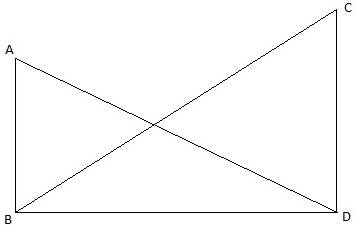The angle of elevation of the top of a building from the foot of a tower is 30°. The angle of elevation of the top of the tower from the foot of the building is 60°. If the tower is 60 m high, find the height of the building.

In the figure, let CD be the tower and AB be the building. Join the points A, D, and B, C. We get two right-angled triangles ∆ABD and ∆BCD, which are right-angled at B and D respectively. We are given that the angle of elevation of the top of the building from the foot of the tower is 30° and that of the top of the tower from the foot of the building is 60°. So, ∠CBD = 60°, ∠ADB = 30°. We are also given that the height of the tower is 60 m. Hence CD = 60 m. We need to find the height of the building, that is AB. For this, we will first find BD from ∆BDC using the trigonometric ratio tan. Using this value of BD, we will find the value of AB from ∆ABD using the trigonometric ratio tan.
In ∆BCD,
![]()
or,
![]()
So, BD = 60/√3m.
In ∆ABD,

or,
![]()
So, height of the building = AB = 20m.